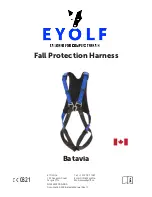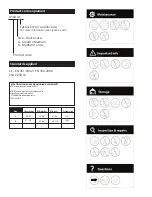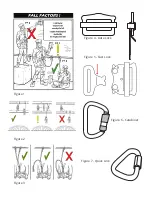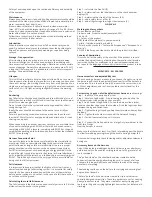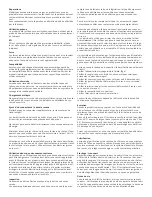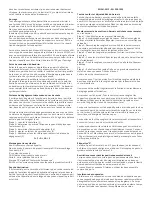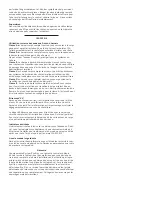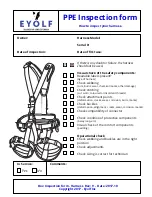
Safety of users depends upon the continued efficiency and durability
of the equipment.
Maintenance
Always keep the product clean and dry. Any excess moisture should be
removed with a clean, dry cloth and then allowed to dry naturally in a
warm room away from direct heat.
Rinse in clean cold water. If still soiled wash in clean warm water
(max. 40°C) with a soft detergent (within pH range of 5.5 to 8.5). Rinse
properly in clean cold water and if needed to disinfect use a solution of
water with alcohol. Do not use bleach!
Follow these instructions, if in doubt about the disinfecting method
please contact us for further details.
Lubrication
When lubrication is needed a silicon or Teflon based spray can be
used. Do not excessively spray the lubricant over the buckle or gate.
Wipe off any excess and protect any webbing or rope from being
sprayed.
Storage - Transportation
After cleaning, store unpacked in a cool, dry, and dark place away
from direct sunlight, as UV will cause damage to the webbing over
time, excessive heat sources, sharp edges, vibration or other possible
causes of damage. Do not store when wet or in a damp area >70%. If
a long shelf life is required it is advisable to store in a moisture proof
package, like a polyethylene bag.
Lifespan
This is difficult to estimate but we advise as follows: Do not use more
than ten years after the date of manufacture. Assuming you have used
the correct storage, the working life can vary from a ten year span to a
single use in extreme circumstances (e.g. highly chemical environment,
serious fall, etc.). UV light including sunlight will reduce the working
life.
Anchoring
Any fall arrest anchorage used should be able to withstand a force of
22kN when not certified or withstand at least two times the Maximum
Arrest Force when engineered.
Do not create slack in the system and avoid any pendulum effect /
swing during a fall.
Ideally the user should be attached to the anchor as vertically as
possible.
For work positioning, restraint and rescue we advise the anchor at
least hold 12kN of force for every person/device attached to it. (Load
sharing is an option)
When connecting to an anchor device or structure use a suitable form
of connector complying with EN 362, either with a shock absorbers,
complying with EN 355, a lanyard, complying with EN 354 or sling and
carabiners depending on the situation you are in. Follow the standard
EN 795 for anchoring.
Harness Connection Point
Connect the lanyard to the harness preferably to the sternal attach-
ment point. When not possible attaching to the ventral attachment
point is allowed as long as falls are impossible or there is a proper
energy absorbance in the system, such as a dynamic rope system.
For fall arrest equipment, such as adding an energy absorber to the
lanyard the right connection point is the Sternal or Dorsal attachment
point, indicated with the letter A on a full body harness complying with
EN 361. This full body harness is the only type of harness suitable for
being used in a fall arrest system.
Fall clearance
It is important to keep in mind that the flight path is clear from any
obstacles when using a fall arresting system. It is essential for safety
to verify the free space required beneath the user at the workplace
before each occasion of use, so that, in the case of a fall, there will be
no collision with the ground.
Calculating the total fall clearance
The fall clearance is the distance required to safely arrest a fall. It is the
distance from the anchor to the ground.
Step 1 – calculate the Free Fall (F)
Step 2 – determine from the label how much the shock absorber
deploys (D)
Step 3 – determine the stretch of the harness (Xh)
Step 4 - add a safety factor of 2m (S)
Step 5 - add all figures together to get the clearance (C)
C=F+D+Xh+S
Markings and/or symbols
On our label you will find:
Product name, Product number (example A500)
Size A or B
B = Colour of the product
DOM (date of Manufacture) in year and month
Serial # - Individual serial # or batch #
CE mark, which stands for “Conformité Européenne” (“European Con-
formity”).
EN 354 is the European standard to which the product is certified.
Country of destination
It is essential for the safety of the user that if the product is re-sold
outside the original country of destination the reseller shall provide
instruction for use, for maintenance, for periodic examination and
for repair in the language of the country in which the product is to be
used.
EN 361:2012 – EN 358:1999
Harness comfort and adjustability test
When choosing a harness make sure you choose the right size, try out
the harness and check the adjustability and comfort of the harness in
a safe place. This is to ensure the (sit) harness is the correct size, has
sufficient adjustment, and is of an acceptable comfort level for the
intended use.
Correct way to put on a full body fall arrest harness
, see drawings
Step 1 - Identify all the parts and lay it out.
Step 2 - Autolock Leg Buckles - Step in the leg loops and pull up the
shoulder straps. (Like putting on your overalls.)
Step 2 Quick Connect Leg Buckles - Put on the harness like a jacket,
have the shoulder straps over the shoulders. Grab the leg straps from
between the leg and fasten them.
Step 3 - Tighten the leg straps by pulling them forward and away from
the body.
Step 4 – Tighten the shoulder straps until the harness fit snugly.
Step 5 – Fasten the sternal strap so it is secure.
Or
Step 5 – Connect the Delta quicklink or a large D style carabiner to the
front two D-rings.
Now the harness is secure.
Make sure that there is at least 5cm (2inch) of webbing past the buckle
to allow for webbing passing through the buckle during a major fall.
It is essential to regularly check fastening and/or adjustment elements
during use.
Accessory items on the harness
Any of the accessory webbing and plastic holders are not attachment
points and only to be used for carrying tools up to 10kg in total of all
tools combined.
The “pull-out loop” on the shoulder band was created to hold a
connector from the energy-absorbing lanyard. In case of a fall on a
Y-lanyard this loop will pull out and eliminate the risk of the energy
absorber not working.
The webbing tool loops on the belt are for carrying and securing tool
bags and tool lanyards.
The two “pockets” on the belt were created to clip in carabiners or
specially designed carrier clips. These two pockets are not for carrying
heavy products or tools. They were created for easily clipping your
tools up to 10kg and carrying lightweight items when, for instance, aid
climbing.

